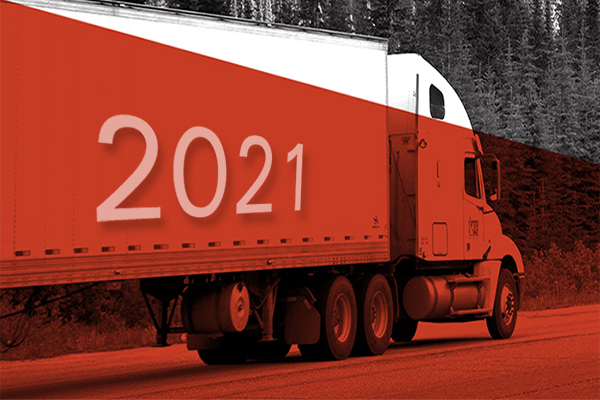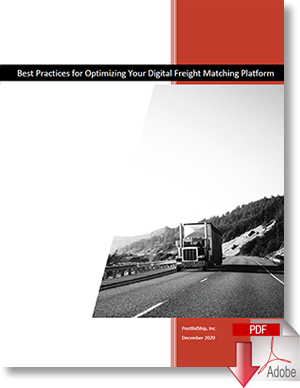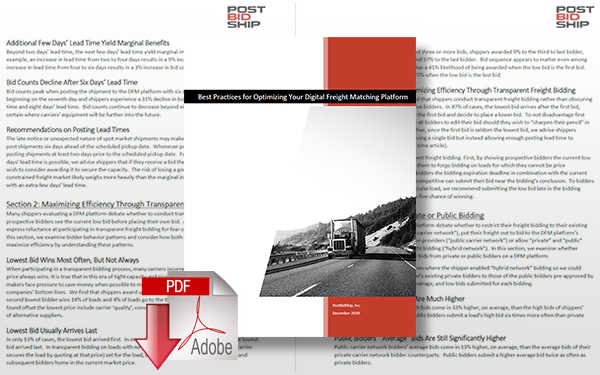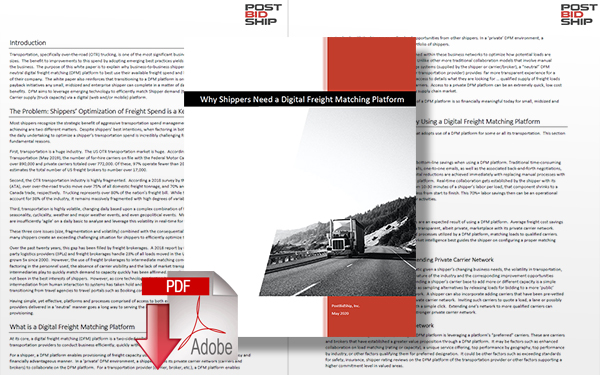2021 Truckload Freight Market Trends and Proactive Steps Shippers Can Take

Charting a course to mitigate high market uncertainty - in this article we first explore the likely freight market trends to shape the coming year and then some recommendations.
Truckload Freight Markets
The past year has experienced dramatic shifts in the truckload freight markets.
Coming off a comparatively quiet 2019 relative to the prior year, 2020 was looking to be perhaps an incremental growth in overall freight markets.
How wrong.
Facing a worldwide community and associated economies under duress caused by the Coronavirus (COVID-19) pandemic with all the associated challenges of moving freight in such an environment, 2020 has been a year of very tight markets, increasing spot rates, and very elevated tender rejection levels.
A September 3rd Wall Street Journal article by Jennifer Smith (“Truckers are Seeing Growing Freight Volumes”) illustrated the nature of the past year;
“Demand measured by the ratio of loads to trucks jumped 132.5% year-over-year in August on trucking’s spot market, where shippers book last-minute transportation, according to online freight marketplace DAT Solutions LLC. The average spot market price to hire a big rig last month was $2.22 per mile, up 22.3% from the previous year.”
Analysis by PostBidShip on its private freight market platform confirms the above.
This data has become common knowledge to shippers dealing with this daily reality in 2020. The question is whether this is just an anomaly brought about by disruption in the freight markets due to a once-in-a-lifetime infectious disease that will return to pre-COVID levels or is there something more to it?
More importantly, how do shippers best position themselves going forward?
In this article, we first explore the likely freight market trends to shape the coming year and then some recommendations.
Trend 1: The Core Factor Affecting Freight Markets is Uncertainty
The one certainty about early 2021 is that it will be a very uncertain time.
A vaccination for COVID-19 is being distributed with the hope that will return life back to normal. Have we seen the worst or is there more to come? Unclear.
There has been substantial disruption to people personally both in terms of income, working arrangements, and daily life. What part will go back to normal and what becomes the “new” environment? Unclear.
A new administration with a likely different approach on many fronts. What changes and what is unchanged? Hard to know.
The Federal Reserve’s monetary policy has attempted to soften the impact on the US population but may have unintended consequences in the coming year. Will inflation remain in check or will capacity constraints, combined with the liquidity in the markets, pressure goods, and services’ pricing upwards? Is fuel headed back up if inflation kicks in? What about drivers’ wages? Uncertain.
Suffice to say this is a period of dramatic uncertainty. As such, few can predict how the business climate plays out in the coming year.
As such, any efforts that are successful in locking in some measure of certainty in such unclear times can be of benefit to mitigate risk. With uncertainty, the need to focus on short-term execution with an eye towards longer-term results is important.
Trend 2: Expect Capacity to Remain Constrained Well into 2021
In the FreightWaves, November 12th article by Todd Maiden (“Schneider CEO Says Only ‘Third Inning’ of Trucking Cycle”), Schneider National CEO and President Mark Rourke said “the industry appears to be still in the early stages of the current trucking cycle, maybe the third inning” during an appearance at Baird’s 2020 Global Industrial Conference. Capacity is simply not returning to the market the way it has in past freight market cycles.
Procuring consistent capacity will be a challenge well into 2021 and it is not for lack of trucks. It is the driver's side of the equation. Driver compensation is now rising to increase the supply. However, a combination of other factors is making it not so simple.
According to the American Trucking Association, the average of an over-the-road, for-hire truckload driver is 46 years of age with the average age of a new drive being trained in 35. The average for a commercial truck driver is even higher, at 55 years of age (US Bureau of Labor Statistics). The Drug & Alcohol Clearinghouse has and will continue to limit the available personnel. COVID has added both concerns to individuals continuing in or entering the trucking industry as well as the challenge of low driver school enrollments during the COVID pandemic.
The federal regulations restricting drivers between the ages of 18 and 20 to drive Class 8 commercial motor vehicles across state lines ensure the over-the-road, for-hire truckload industry remains systemically weakened as a career path to its greatest pool of new drivers … recent high school graduates looking to start a career.
Finally, as the US market truly re-opens, the backlog of demand for goods and resupply of operations storing said goods may ensure sustained demand beyond more traditional levels.
With time and focus, capacity bottlenecks can be reduced but heading into 2021, capacity will remain a constraint and lead to elevated freight rates and less-than-desired guaranteed capacity.
Trend 3: Supply Chains Morphed
In 2020, supply chains have morphed out of necessity. They got “lumpy” due to certain industries getting ravaged and other industries getting elevated as a result of the pandemic. At the same time, the off-on-off nature of the varied COVID responses by states and by geographic regions has contributed to this “lumpy” nature with more unpredictable demand in the freight markets leading to ‘winners’ and ‘losers’.
The ongoing transformation of the retail markets from less shopping within brick-and-mortar stores and more e-commerce, ‘direct to consumer’, and ‘curb-side pickup’ has only accelerated during the past year’s lockdowns. With a new consumer behavior pattern established, there is speculation that there may never be a return to prior levels of fulfillment direct to the consumer and that the warehouse will be the new retail occupation.
These new supply chains were not constructed for efficiency. They were constructed for necessity and that differentiation means there will require time for them to become efficient and operate near to past cost levels.
Trend 4: Freight Rates Will Continue at Elevated Levels Well into 2021
When combining the above macro-level trends … a highly uncertain economic climate with systemic capacity constraints and substantially altered supply chains … one very clear outcome is sustained upward pressure on freight rates. Driver compensation is known to be increasing to address the driver shortage. Insurance is again on the upswing as the trucking industry witnesses greater litigation risk over the past couple of years. Not to mention that inflationary pressures resulting from the 2020 monetary policy could well exacerbate all the above and add increased fuel costs as well.
As noted earlier in this article, over-the-road truckload spot rates have increased, on average over 22%. However, that is an average, and some shippers have experienced freight rate increases on the same loads/lanes in the 30-50% range over the past three quarters.
What Proactive Steps Can Shippers Take to Mitigate Challenging Freight Markets
Shippers face these multiple trends heading into 2021 that will all support continued headwind for transportation operations that are either traditional or more recently reliant upon the spot freight market. Those that already were operating extensively in the spot market are witnessing higher costs and fewer options. Those that are now required to operate more in the spot markets since their contract tender rejections have gone up to face similar difficulties.
What are pragmatic, proactive steps that can be taken to mitigate the uncertainty and challenges?
- First, attempt to be less transactional in nature by establishing a pool of fewer but stronger and more committed working relationships for specified durations.
- Second, find a middle ground with these carriers to share higher-than-desired rate levels and increases in return for a commitment of guaranteed capacity.
In consultation with customers and market experts over the past half-year, PostBidShip has crafted one such solution to aid both parties. PostBidShip will help both shippers and carriers to share in the benefits and jointly mitigate the challenges by introducing its “Spot Contract” functionality to the platform for 2021.
The Spot Contract permits shippers to invite selected carriers and brokers to bid on its most predictable freight by pre-accepting specified volume levels for a relatively short duration at a target price. In return, carriers and brokers are awarded portions of the volume for that duration in return for the accepted price levels for each awarded bidder. This permits active spot market shippers and their carriers to agree on efficiently collaborating for these periods without additional quoting.
For shippers used to the annual contract RFP process, the Spot Contract can be used for 2021 and keep shorter time horizons. Defer the contract RFP process and leverage Spot Contract to be incremental in nature … part contract and part spot … with the goal to get guaranteed capacity, albeit for shorter durations in return for some variability in freight rates between spot contracts. The freight market’s return to more equilibrium conditions would determine the duration and extent of the use of Spot Contracts.
Besides mitigating the headwinds in the freight markets entering 2021, Spot Contract is ideal for locking in best rates during seasonal peaks and/or for short term projects (construction job sites, produce seasons, product line seasonality, etc.).
About PostBidShip
PostBidShip is a neutral digital freight platform that replaces outdated workflows with the quick, cost-effective, and efficient matching of loads to transportation capacity in real-time, using near-time data analytics, market indices modeling and real-time digital collaboration, benefiting both parties through an optimal mix of cost, performance, convenience and asset utilization.
Related Article Optimizing Your Digital Freight Matching Platform: Selecting Private or Public Bidding
Related Papers
Best Practices for Optimizing Your Digital Freight Matching Platform
The purpose of this white paper is to provide best practices for optimizing the use of a digital freight matching platform in several key areas; posting lead times, transparent freight bidding, and using private or public markets. Download Now!
Why CARRIERS Need a Digital Freight Matching Platform
This white paper explains why business-to-business carriers today benefit from access to a neutral digital freight matching platform to best use their available capacity, resources, and equipment. Download Now!
Why SHIPPERS Need a Digital Freight Matching Platform
This white paper explains why business-to-business shippers today benefit from access to a neutral digital freight matching platform to best use their available freight spend and human capital resources on behalf of their company. Download Now!
More PostBidShip Resources
Article Topics
PostBidShip News & Resources
2021 Truckload Freight Market Trends and Proactive Steps Shippers Can Take Optimizing Your Digital Freight Matching Platform: Selecting Private or Public Bidding Best Practices for Optimizing Your Digital Freight Matching Platform Leveraging Carrier and Shipper Feedback to Improve the Digital Freight Matching Experience Optimizing Digital Freight Matching: Maximizing Efficiency Through Transparent Freight Auctions Optimizing Digital Freight Matching Platforms: Posting Lead Times to Maximize Spot Market Response Expanding Visibility, Operating Efficiency, and Market Intelligence for Shippers & Carriers More PostBidShipLatest in Transportation
Talking Supply Chain: Doomsday never arrives for Baltimore bridge collapse impacts Amazon Logistics’ Growth Shakes Up Shipping Industry in 2023 Nissan Channels Tesla With Its Latest Manufacturing Process Why are Diesel Prices Climbing Back Over $4 a Gallon? Luxury Car Brands in Limbo After Chinese Company Violates Labor Laws The Three Biggest Challenges Facing Shippers and Carriers in 2024 Supply Chain Stability Index: “Tremendous Improvement” in 2023 More Transportation


















